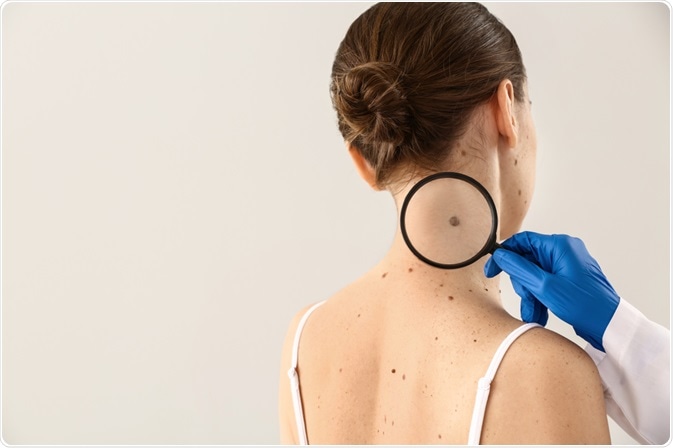The symptoms of melanoma usually present initially as changes in the appearance of the skin, which is caused by changes in how melanocytes are produced.
 Melanoma Symptoms and Cause" />
Melanoma Symptoms and Cause" />
Image Credit: Pixel-Shot / Shutterstock.com
Symptoms
Moles normally appear on healthy skin and do not necessarily represent an early sign of melanoma. Moles are usually evenly colored and may be round or oval, and can also be flat or raised from the surface. These moles typically appear in childhood or adolescence and stay unchanged for many years.
The development of melanoma may be recognized by changes to the skin, particularly regarding the size, shape, and color of moles. The ABCDE rule is used to guide the parameters to look for when checking for melanoma, which includes:
- Asymmetry: The uneven shape of a mole or birthmark.
- Border: Irregular or blurred edge of a mole or birthmark.
- Color: Various color shades or patches of mole or birthmark.
- Diameter: A spot larger than 6 millimeters (mm), or ¼ inch, in diameter.
- Evolving: The mole changes its size, shape, or color.
However, these signs do not encompass all forms of melanoma. It is therefore important to consider abnormal changes or the appearance of new spots on the skin. In particular, changes that look different from the rest of the moles on the skin of the individual, or those occurring at an elder age, are of greater concern.
Skin Cancer Screening | Symptoms, Types & Warning Signs
Other warning signs of melanoma include:
- A sore that does not heal as normal
- Spread of pigment to skin surrounds the spot
- Redness or swelling around the area
- Itchiness, tenderness, or pain in the area
- Scaliness, oozing, or bleeding from the spot.
Causes
There are two main causes of melanoma that have been identified to date, which include exposure to ultraviolet (UV) radiation from the sunlight and genetic susceptibilities.
Exposure to UV radiation was suggested as a causative factor for melanoma by Henry Lancaster, who was an Australian mathematician who noted the high incidence of melanoma in Australian individuals who were exposed to a significant amount of sunlight.
This notion has since been supported by various scientific studies, including those that associated the use of tanning beds that utilized UV radiation with an increased risk of melanoma. According to the International Agency for Research on Cancer, tanning beds are carcinogenic to humans. To this end, individuals who begin using them before the age of 30 face a relative risk 75% higher than other individuals to develop melanoma.
Additionally, people with a workplace environment that has high exposure to UV radiation, such as farmers and those working on airplanes, also face a higher risk than other individuals. The skin cells can absorb UVA and UVB light, which causes damages to the DNA by inducing the formation of cyclobutane pyrimidine dimers (CPDs).
The characteristics of the individual's skin, including the color, pigmentation, and age at exposure can also affect the risk of melanoma. The highest incidence is seen in populations with fair skin living in areas with high exposure to UV radiation from sunlight, such as European settlers in Australia.
There are also some specific gene mutations that are associated with an increased susceptibility for melanoma. One class of genetic mutations involves changes to the CDKN2A gene, which alters the stability of the p53 transcriptional factor and causes apoptosis related to cancer.
Individuals with a mutation in the MC1R gene have a relative risk of two to four times higher than the general population of developing melanoma. This gene is very common and is present in all members of the population with red hair.
A strong family history of melanoma also increases the risk of an individual to suffer from the condition, due to the possibility of a mutated gene inheritance that may increase the susceptibility to UV radiation.
References
Further Reading
Last Updated: Apr 22, 2021